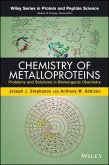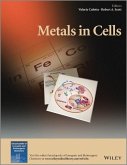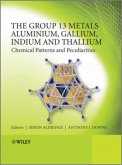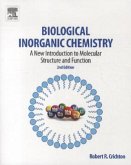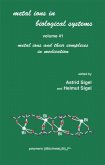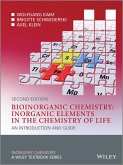- Broschiertes Buch
- Merkliste
- Auf die Merkliste
- Bewerten Bewerten
- Teilen
- Produkt teilen
- Produkterinnerung
- Produkterinnerung
This guide serves both as an excellent course text for advanced undergraduates and postgraduates, and as a reference for anyone working in this area. Already praised by specialists in the field, this text gives both an overview of biological inorganic chemistry and presents a detailed look at metal-ion containing biological systems.
Andere Kunden interessierten sich auch für
![Chemistry of Metalloproteins Chemistry of Metalloproteins]() Joseph J. StephanosChemistry of Metalloproteins130,99 €
Joseph J. StephanosChemistry of Metalloproteins130,99 €![Metals in Cells Metals in Cells]() Metals in Cells213,99 €
Metals in Cells213,99 €![The Group 13 Metals Aluminium, Gallium, Indium and Thallium The Group 13 Metals Aluminium, Gallium, Indium and Thallium]() Simon AldridgeThe Group 13 Metals Aluminium, Gallium, Indium and Thallium288,99 €
Simon AldridgeThe Group 13 Metals Aluminium, Gallium, Indium and Thallium288,99 €![Biological Inorganic Chemistry Biological Inorganic Chemistry]() Robert R. CrichtonBiological Inorganic Chemistry91,80 €
Robert R. CrichtonBiological Inorganic Chemistry91,80 €![Metal Ions in Biological Systems Metal Ions in Biological Systems]() Astrid Sigel / Helmut SigelMetal Ions in Biological Systems391,99 €
Astrid Sigel / Helmut SigelMetal Ions in Biological Systems391,99 €![Bioinorganic Chemistry -- Inorganic Elements in the Chemistry of Life Bioinorganic Chemistry -- Inorganic Elements in the Chemistry of Life]() Wolfgang KaimBioinorganic Chemistry -- Inorganic Elements in the Chemistry of Life186,99 €
Wolfgang KaimBioinorganic Chemistry -- Inorganic Elements in the Chemistry of Life186,99 €![Metalloprotein Active Site Assembly Metalloprotein Active Site Assembly]() Metalloprotein Active Site Assembly186,99 €
Metalloprotein Active Site Assembly186,99 €-
-
-
This guide serves both as an excellent course text for advanced undergraduates and postgraduates, and as a reference for anyone working in this area. Already praised by specialists in the field, this text gives both an overview of biological inorganic chemistry and presents a detailed look at metal-ion containing biological systems.
Produktdetails
- Produktdetails
- Verlag: MIT Press / University Science Books
- Artikelnr. des Verlages: 978-1-938787-96-6
- Seitenzahl: 740
- Erscheinungstermin: 1. Januar 2007
- Englisch
- Abmessung: 266mm x 204mm x 43mm
- Gewicht: 1686g
- ISBN-13: 9781938787966
- ISBN-10: 193878796X
- Artikelnr.: 49408327
- Herstellerkennzeichnung
- Libri GmbH
- Europaallee 1
- 36244 Bad Hersfeld
- gpsr@libri.de
- Verlag: MIT Press / University Science Books
- Artikelnr. des Verlages: 978-1-938787-96-6
- Seitenzahl: 740
- Erscheinungstermin: 1. Januar 2007
- Englisch
- Abmessung: 266mm x 204mm x 43mm
- Gewicht: 1686g
- ISBN-13: 9781938787966
- ISBN-10: 193878796X
- Artikelnr.: 49408327
- Herstellerkennzeichnung
- Libri GmbH
- Europaallee 1
- 36244 Bad Hersfeld
- gpsr@libri.de
Harry Barkus Gray is the Arnold O. Beckman Professor of Chemistry and the Founding Director of the Beckman Institute at the California Institute of Technology. His main research interests center on inorganic spectroscopy, photochemistry, and bioinorganic chemistry, with emphasis on understanding electron transfer in proteins. For his contributions to chemistry, which include over 700 papers and 17 books, he has received the National Medal of Science from President Ronald Reagan (1986); the Linderstrøm-Lang Prize (1991); the Basolo Medal (1994); the Gibbs Medal (1994); the Chandler Medal (1999); the Harvey Prize (2000); the Nichols Medal (2003); the National Academy of Sciences Award in Chemical Sciences (2003); the Benjamin Franklin Medal in Chemistry (2004); the Wolf Prize in Chemistry (2004); the City of Florence Prize in Molecular Sciences (2006); six national awards from the American Chemical Society, including the Priestley Medal (1991); and 16 honorary doctorates. He is a member of the National Academy of Sciences; the American Academy of Arts and Sciences; the American Philosophical Society; an honorary member of the Italian Chemical Society; a foreign member of the Royal Danish Academy of Sciences and Letters; the Royal Swedish Academy of Sciences; and the Royal Society of Great Britain. He was California Scientist of the Year in 1988.
CONTENTS
I Introduction and Text Overview
PART A: OVERVIEWS OF BIOLOGICAL INORGANIC CHEMISTRY
II Bioinorganic chemistry and the biogeochemical cycles
III Metal ions and proteins: Binding, stability and folding
IV Special cofactors and metal clusters
V Transport and storage of metal ions in biology
VI Biominerals and biomineralization
VII Metals in medicine
PART B: METAL-ION CONTAINING BIOLOGICAL SYSTEMS
VIII Metal ion transport and storage
IX Hydrolytic chemistry
X Electron transfer, respiration and photosynthesis
XI Oxygen metabolism
XII Hydrogen, carbon, nitrogen, and sulfur metabolism
XIII Metalloenzymes with radical intermediates
XIV Metal ion receptors and signaling
TUTORIALS
Tutorial I Cell biology, biochemistry and evolution
Tutorial II Fundamentals of coordination chemistry
Appendices
Index
I Introduction and Text Overview
PART A: OVERVIEWS OF BIOLOGICAL INORGANIC CHEMISTRY
II Bioinorganic chemistry and the biogeochemical cycles
III Metal ions and proteins: Binding, stability and folding
IV Special cofactors and metal clusters
V Transport and storage of metal ions in biology
VI Biominerals and biomineralization
VII Metals in medicine
PART B: METAL-ION CONTAINING BIOLOGICAL SYSTEMS
VIII Metal ion transport and storage
IX Hydrolytic chemistry
X Electron transfer, respiration and photosynthesis
XI Oxygen metabolism
XII Hydrogen, carbon, nitrogen, and sulfur metabolism
XIII Metalloenzymes with radical intermediates
XIV Metal ion receptors and signaling
TUTORIALS
Tutorial I Cell biology, biochemistry and evolution
Tutorial II Fundamentals of coordination chemistry
Appendices
Index
CONTENTS
I Introduction and Text Overview
PART A: OVERVIEWS OF BIOLOGICAL INORGANIC CHEMISTRY
II Bioinorganic chemistry and the biogeochemical cycles
III Metal ions and proteins: Binding, stability and folding
IV Special cofactors and metal clusters
V Transport and storage of metal ions in biology
VI Biominerals and biomineralization
VII Metals in medicine
PART B: METAL-ION CONTAINING BIOLOGICAL SYSTEMS
VIII Metal ion transport and storage
IX Hydrolytic chemistry
X Electron transfer, respiration and photosynthesis
XI Oxygen metabolism
XII Hydrogen, carbon, nitrogen, and sulfur metabolism
XIII Metalloenzymes with radical intermediates
XIV Metal ion receptors and signaling
TUTORIALS
Tutorial I Cell biology, biochemistry and evolution
Tutorial II Fundamentals of coordination chemistry
Appendices
Index
I Introduction and Text Overview
PART A: OVERVIEWS OF BIOLOGICAL INORGANIC CHEMISTRY
II Bioinorganic chemistry and the biogeochemical cycles
III Metal ions and proteins: Binding, stability and folding
IV Special cofactors and metal clusters
V Transport and storage of metal ions in biology
VI Biominerals and biomineralization
VII Metals in medicine
PART B: METAL-ION CONTAINING BIOLOGICAL SYSTEMS
VIII Metal ion transport and storage
IX Hydrolytic chemistry
X Electron transfer, respiration and photosynthesis
XI Oxygen metabolism
XII Hydrogen, carbon, nitrogen, and sulfur metabolism
XIII Metalloenzymes with radical intermediates
XIV Metal ion receptors and signaling
TUTORIALS
Tutorial I Cell biology, biochemistry and evolution
Tutorial II Fundamentals of coordination chemistry
Appendices
Index


